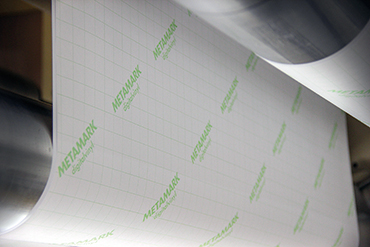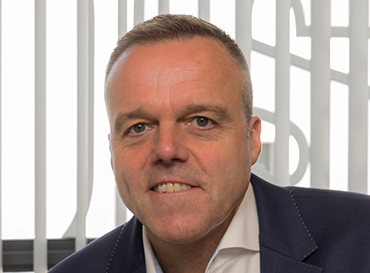Today it’s a major supplier to the UK and global markets, moving with the times to respond to new technologies, but also making a big effort on the environmental front. It has developed PVC-free self-adhesive plastic media and is also pioneering an end-to-end tracking operation with signage producers and vehicle wrappers, to recover and recycle vinyl and other materials at the end of their lives.
Metamark describes its founders as a partnership of coated plastics experts. Computerised signmaking using cutting plotters rather than printing was in the ascendant at the time. Metamark was able to improve the performance of coloured self-adhesive materials at the cutting and weeding stages. Among its achievements were a lay-flat paper liner and new adhesive classes. It also introduced colours appealing to designers, rather than just matching industrial paints.
However, the founders were also already experienced with the development and commercialisation of printed, self-adhesive films used in the field of domestic decor and surface transformation. Long before digital printing emerged, self-adhesive plastics were already used with high-speed flexo, gravure or screen printing using solvent ink. This experience was later to become very valuable when inkjets with piezo heads were introduced. These could run solvent-based inks whose pigments bonded with the top surface of the plastics for long outdoor durability. Metamark introduced the self-adhesive media that’s a mainstay of its current lines.
Management buyout
Two of the founder directors, Mark Bateson and Mike Stuart, were with Metamark until 2017, when there was a £62m management buyout led by CEO Paul French and UK sales director Ian Simister, backed by Primary Capital Partners.
French has been CEO since 2012. He previously worked for paper merchant Robert Horne from 2006 to 2012 with the last two years as managing director. Prior to that he was managing director of Spandex, a big player in the signage printing equipment market.
Simister has been with Metamark since 2013 and previously worked for Robert Horne, then PaperlinX.
Metamark’s customer base today is largely signage, graphics and vehicle wrappers using digital print and cutting systems. However it also sells to commercial and domestic decor producers and recently a growing market of automotive specialists in paint protection.
Since the buyout was completed the number of employees has risen from 88 to 155, and turnover has grown consistently each year.
Manufacturing base
Metamark’s main factory has always been in Lancaster, where the admin and main warehousing is also based. Making self-adhesive materials is a specialist business and the company has several production lines working with bespoke adhesive systems and proprietary raw materials.
There’s also a site in Woking, handling domestic sales and marketing. Until recently Woking handled converted inventory and shipping to domestic markets. “However, this was consolidated into Lancaster to help the company advance on its environmental goals, as this would favourably impact road miles and carbon footprint,” he explains.
New product development is piloted in Lancaster, with input from the product management team in Woking. “Metamark puts a considerable emphasis on introducing products that reflect market need,” says Simister.
Also working at the Lancaster site are manufacturing experts and operators, conversion specialists, technical staff and the international sales and marketing team. “The company has a progressive approach to management and trains its staff as part of its personnel development plan,” he notes.
Sales and support
Metamark sells directly in the UK through its HQ and regional sales force. International sales go through distributors. “This provides a great channel of communication feeding into product development and improvement, and Metamark also has a capacity for invention too,” says Simister.
New product development is piloted in Lancaster, with input from the commercial management team in Woking. “Metamark puts a considerable emphasis on introducing products that reflect market need,” says Simister.
Products are formulated with current production methods in mind, but customers may need some hand-holding to get the best results with particular types of work, or when trying new things.


“Real people man the support function at Metamark and they understand the products and application sphere well,” he says proudly. “Customers often cite support as being among Metamark’s many strengths. In addition to frontline telephone support there is a huge library of material available to customers, detailing its products. We make sure we have big stocks available so our customers don’t need to tie up cash in inventory they may only have to use occasionally.”
Product lines
The full range of media listed in the company catalogue is extensive, taking in coloured vinyls; outdoor media; promotional media (for POS, exhibitions, etc); vehicle wrapping; window graphics; floor and wall coverings, metallized films, reflective and fluorescent media; banner materials; display systems and paper; textiles and canvas; lightbox fabrics; anti-graffiti materials; and speciality media such as chalkboard, holographic and photoluminescent. The company also supplies accessories, tools and consumables for signmakers and wrappers, plus downloadable ICC material profiles for a long list of large-format inkjets, and colour palettes for design programs.
This is Metamark’s 30th year and some of its products are seeing major birthdays too. Metamark MD5 is 21. This is a flagship of its digital media portfolio, launched at a time when digital printing was still emerging as a viable production means. “Unlike many materials at the time, which just happened to work to an acceptable extent, more or less by accident, MD5 was expressly formulated for digital print and said to be digital by design,” says Simister. “It handled large ink loads without complaint, dried and handled well and yielded potent results. Today’s MD5 line includes a number of variants, making it one of the industry’s go-to media products.”
Going back to the early days of Metamark, M7 is a range of coloured self-adhesive materials for cutters, that has been progressively enhanced and refined. “The range is designed around the belief that ‘colour is everything’ and every member of the range has a personality to impart,” says Simister. “Despite digital print, M7 is popular and the range is still being managed, enhanced and refined.”
Environmental emphasis
A big part of the company’s strategic thinking is environmental responsibility. “Given the strategic importance the company attaches to its being a responsible citizen in today’s world, the environment and its wellbeing are central to Metamark’s development trajectory,” says Simister. Metamark recently launched MetaStream, its process for recycling vinyl and liner, which is now up and running.
Vinyl is short for polyvinyl chloride (PVC) and is not a particularly eco-friendly plastic (a particular offender being the plasticisers used to make it flexible), though there are worse. It’s bad if it’s dumped (plasticisers eventually leach out), worse if it’s burnt (dioxins can be released), but it can be recycled several times if it is recovered after use. Although printers and signmakers will often try to dispose of their own waste materials responsibly, they tend to lose track and control after the printed products are delivered. MetaStream is intended to solve this by tracking and recovering media at all stages.
Metamark’s Iain Wallace is the programme’s architect and he manages its commercial direction. He says: “MetaStream is our response to the need to reduce the impact of our operation overall. We were aware that significant amounts of self-adhesive vinyl share a destiny in either incineration waste-streams or landfill sites, and that included waste from our own production. We established a zero-to-landfill programme and devised MetaStream initially to get us to zero.
“Waste vinyl and paper now enter MetaStream and are recycled rather than buried or burnt. The paper elements, the liners in other words, become luxury goods like greetings cards and notebooks. The vinyl elements become useful plastic goods that can themselves be recycled time and time again. Nothing is buried. Nothing is burnt.

Ian Simister
“We launched MetaStream recently so that our larger customers could participate and in turn help the brands they supply reduce environmental impact. Through these larger converter customers, MetaStream now handles a wide range of qualified Metamark materials, regardless of whether they’re laminated or printed. We can even recycle our own anti-graffiti products.
“Customer reaction has been immediate and enthusiastic. Our plan for MetaStream now includes taking it to those of our customers who are lower-volume users and giving it an international footprint. We’re also working on carbon offsetting initiatives.”
Although most people will associate ‘self-adhesive’ with ‘vinyl’, this isn’t the only plastic suitable for this type of work. Wallace says that Metamark has introduced MD-E2, a PVC-free material for shorter-term applications. This can also be recycled via MetaStream. The emphasis though is on MetaStream handling proven materials, such as vinyl, that the industry has been using for many years.
Like all other companies, Metamark is also subject to current world events, as Simister points out. “Nothing much gets done in industry without energy being used and that is getting very costly.”
The company runs a commendably efficient manufacturing operation and manages its pricing so that it remains attractive and competitive. It seems to be working. Metamark is doing more business with more customers and is offering more products than at any time in its 30-year history.
STAR PRODUCT
The MD-Class portfolio is at the core of Metamark’s range of self-adhesive digitally printed media. It includes “high performance,” “performance” and “intermediate” materials for different price/performance/lifetime requirements and applications in signage, windows and vehicle graphics. The materials are generally compatible with solvent eco-solvent, Latex and UV-cure inks. The range includes white gloss, white matt or clear materials (and matched clear protective overlaminates), with general-purpose plus speciality adhesives such as high-tack or removable. Some have blockout characteristics to prevent show-through on windows.










